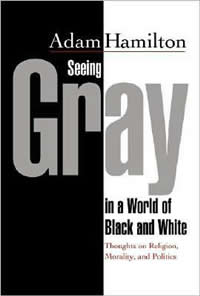Book Notes
 Adam Hamilton, Seeing Gray in a World of Black and White (Nashville: Abingdon, 2008), 246pp.
Adam Hamilton, Seeing Gray in a World of Black and White (Nashville: Abingdon, 2008), 246pp.
In 1990 Adam Hamilton founded the United Methodist Church of the Resurrection in Leawood, Kansas. After starting with four people, today their weekly attendance numbers about 7500 worshippers. Along the way, Hamilton has written at least a half-dozen books, the most current one urging a "radical center" that moves beyond the tired debates between evangelical conservatives and mainline liberals. Elsewhere Hamilton has advanced the language of "liberal evangelical" or "evangelical liberal."
"This book," he writes, "is my attempt at laying out one Christian's view of a Christianity of the via media or middle way between the extremes" of a Jerry Falwell and John Shelby Spong. That's not to say he argues for a mushy middle or some lowest common denominator. Far from it. The call of Jesus is radical. But because of the transcendence of God and the fallenness of humanity, we should never claim to understand the Jesus Way perfectly. Nor do we have to, for to do so would be a horrible burden.
What Hamilton argues for is not moderation but modesty. He embodies the so-called "peace-saying" of Peter Meiderlin, a Lutheran pastor who had grown tired of the rancor and division caused by doctrinal disputes in the wake of the Protestant Reformation. In the early 1620s he wrote a book under the pen name of Rupert Meldenius, entitled A Prayerful Admonition for Peace to the Theologians of the Augsburg Confession. In it he urged “in essentials unity, in non-essentials liberty, and in all things charity.”
Hamilton is a fine example of an articulate pastor who's followed the Wesleyan quadrilateral of Scripture, tradition, reason, and experience. He has listened carefully for the intimations of the Spirit in his own life and in the lives of his parishioners, then incorporated these experiences into his reasoned interpretation of Scripture. He tackles head-on a dozen or so litmus-test issues that have divided Christians — the Bible, science, evolution, world religions, hell, evil, doubt, ethics, abortion, homosexuality, war and politics. These are short chapters with sparse footnotes and excellent stories. They aren't intended as a substitute for a deeper study of complex issues that Hamilton would robustly recommend. Rather, what we get is the opportunity to look over the shoulder of a gifted pastor as he studies the Scriptures, cares deeply for his people, and celebrates the good news of Jesus.
Questions at the end of the book for each chapter encourage deeper reflection. I would have enjoyed a list of books "for further reading." Readers who expect Hamilton to "solve" the problems he raises will be disappointed, because that's precisely what he doesn't do. In the twenty-three short chapters he makes no pretense of offering a comprehensive analysis of the questions. Rather, he illustrates in a winsome manner how one believer has taken to heart the advice in one of John Wesley's most famous sermons ("Catholic Spirit" from 1755): "Though we cannot think alike, may we not love alike? May we not be of one heart, though we are not of one opinion? Without all doubt, we may. Herein all the children of God may unite, notwithstanding these smaller differences" (231, 236).


